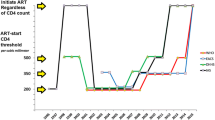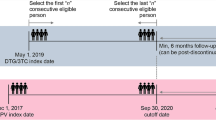Abstract
Background: The impact on healthcare resource use of adding lamivudine to concurrent zidovudine-containing antiretroviral regimens was studied as a part of a 52-week multinational study [CAESAR (Canada, Australia, Europe and South Africa)] in HIV-infected patients with moderate to severe immunodeficiency (25 to 250 CD4+ cells/mm3).
Results: Significantly fewer lamivudine than placebo recipients required hospitalisations (p = 0.002), unscheduled outpatient visits (p = 0.013) or prescribed medications for HIV-related illness (p < 0.001). The mean number of hospitalisations and the mean duration of hospitalisation for HIV-related illness were 47% and 51% lower, respectively, with lamivudine than with placebo. The mean number of unscheduled outpatient visits was 32% lower with lamivudine than with placebo. Lamivudine was also associated with a significant reduction in the number of patients who were hospitalised (p = 0.04) or required unscheduled outpatient visits (p = 0.02) as a result of adverse events.
Conclusions: Notwithstanding the fact that retrospective studies have suggested that more effective antiretroviral treatments reduce healthcare use, the CAESAR study is one of the few prospective controlled trials to demonstrate that by slowing disease progression with combination therapy it is possible to reduce healthcare resource use in patients with HIV infection. Although the combination of lamivudine and zidovudine alone is not likely to be sufficient to achieve complete long term suppression of viral replication and to halt disease progression, the study demonstrates the immediate economic benefits of preventing HIV progression in HIV-infected patients with moderate to severe immunodeficiency (25 to 250 CD4+ cells/mm3). These findings suggest that treatment regimens that slow progression of HIV infection have the potential to produce savings in non-drug healthcare costs, which may partly or fully offset the drug costs.
Similar content being viewed by others
References
DELTA Coordinating Committee. DELTA: a randomized double-blind controlled trial comparing combinations of zidovudine plus didanosine or zalcitabine with zidovudine alone in HIV infected individuals. Lancet 1996; 348: 283–91
Randomized trial of addition of lamivudine or lamivudine plus loviride to zidovudine-containing regimens for patients with HIV-1 infections: the CAESAR trial. Lancet 1997; 349: 1413–21
British HIV Association guidelines for antiretroviral treatment of HIV seropositive individuals. BHIVA Guidelines Coordinating Committee. Lancet 1997; 349 (9058): 1086–92
Payne N. British HIV Association guidelines for antiretroviral treatment of HIV seropositive individuals. Lancet 1997; 349: 1837
Petrou S, Dooley M, Whitaker L, et al. The economic costs of caring for people with HIV infection and AIDS in England and Wales. Pharmacoeconomics 1996; 9 (4): 332–40
Brettle RP, Atkinson FI, Wilcock J, et al. The cost of health care for HIV-positive patients. Int J STD AIDS 1997; 8: 50–3
Fortgang IS, Moore RD. Hospital admissions of HIV infected patients from 1988 to 1992 in Maryland. J Acquir Immune Defic Syndr Hum Retrovirol 1995; 8: 365–72
Moore RD, Bartlett JG. Combination antiretroviral therapy in HIV infection: an economic perspective. Pharmacoeconomics 1996; 10 (2): 109–13
Eron JJ, Benoit SL, Jemesk J, et al. Treatment with lamivudine, zidovudine, or both in HIV-positive patients with 200 to 500 CD4+ cells per millimetre. N Engl J Med 1995; 333: 1662–9
Staszewski S, Loveday C, Picazo JJ, et al. Safety and efficacy of lamivudine-zidovudine combination therapy in zidovudine-experienced patients. JAMA 1996; 276: 111–7
Lacey L, Hill A, Mauskopf J. The incidence of opportunistic infections and hospitalisations in HIV patients treated with lamivudine/zidovudine [abstract P37]. 3rd International Congress on Drug Therapy and HIV Iinfection; 1996 Nov 3-7; Birmingham, UK. AIDS 1996; 10 Suppl. 2: S28
Anis H, Hogg RS, Wang X, et al. The effect of attenuating CD4 decline on subsequent hospitalisation: potential benefit of viral load driven antiretroviral therapy [abstract 263]. 4th Conference on Retroviral and Opportunistic Infections; 1997 Jan 22-26; Washington DC: 1997: 112
Mouton Y, Alfandari S, Valette M, et al. Impact of protease inhibitors on AIDS defining events and hospitalisations in 10 French AIDS reference centres. AIDS 1997 Oct; 11 (12): F101–5
Anis AH, Hogg RS, Wang X, et al. Modelling the potential economic impact of viral load driven triple drug combination antiretroviral therapy. Pharmacoeconomics 1998; 13 (6): 697–705
Centers for Disease Control and Prevention. 1993 revised classification system for HIV infection and expanded surveillance case definition for AIDS among adolescents and adults. MMWR Morb Mortal Wkly Rep 1992; 41 (RR-17): 1–19
Mauskopf JA, Lacey LA, Kempel A, et al. The cost effectiveness of treatment with lamivudine and zidovudine compared to zidovudine alone: a comparison of Markov model and trial estimates. Am J Manag Care 1998; 4 (7): 1004
Carpenter CCJ, Fischl MA, Hammer SL, et al. Antiviral therapy for HIV infection in 1998. Updated recommendations of the International AIDS Society — USA Panel. JAMA 1998; 280: 78–86
Gazzard B, Moyle G, on behalf of the BHIVA Guidelines writing committee. 1998 revision to the British HIV Association guidelines for antiretroviral treatment of HIV seropositive individuals. Lancet 1998; 352: 314–6
Chancellor JV, Hill AM, Sabin CA, et al. Modelling the cost effectiveness of lamivudine/zidovudine combination therapy in HIV infection. Pharmacoeconomics 1997; 12 (1): 54–66
Lacey L, Mauskopf J, Lindrooth R, et al. A prospective costconsequence analysis of adding lamivudine to zidovudinecontaining antiretroviral treatment regimens for HIV infection in the US. Pharmacoeconomics 1999; 15 Suppl. 1: 23–38
Lacey L, Youle M, Trueman P, et al. A prospective evaluation of the cost effectiveness of adding lamivudine to zidovudinecontaining antiretroviral treatment regimens in HIV infection: European perspective. Pharmacoeconomics 1999; 15 Suppl. 1: 39–53
Author information
Authors and Affiliations
Rights and permissions
About this article
Cite this article
Lacey, L., Gill, M. Lamivudine Reduces Healthcare Resource Use when Added to Zidovudine-Containing Regimens in Patients with HIV Infection. Pharmacoeconomics 15 (Suppl 1), 13–22 (1999). https://doi.org/10.2165/00019053-199915001-00002
Published:
Issue Date:
DOI: https://doi.org/10.2165/00019053-199915001-00002




